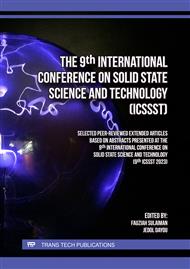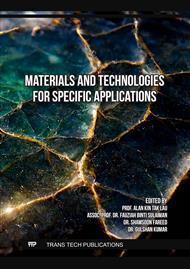[1]
L. Yang, Z. G. Chen, and J. Zou, High-Performance Thermoelectric Materials for Solar Energy Application, Emerging Materials for Energy Conversion and Storage, Elsevier. (2018) 3–38.
DOI: 10.1016/b978-0-12-813794-9.00001-6
Google Scholar
[2]
M. Wolf, R. Hinterding, & A. Feldhoff, High Power Factor vs. High zT—A Review of Thermoelectric Materials for High-Temperature Application, Entropy. (2019) 1058.
DOI: 10.3390/e21111058
Google Scholar
[3]
M. Bilal, S. Jalali-Asadabadi, R. Ahmad, and I. Ahmad, Electronic Properties of Antiperovskite Materials from State-of-the-Art Density Functional Theory, J. Chem. 2015 (2015) 1–11.
DOI: 10.1155/2015/495131
Google Scholar
[4]
J. Nuss, C. Mühle, K. Hayama, V. Abdolazimi, and H. Takagi, Tilting structures in inverse perovskites, M3TtO (M = Ca, Sr, Ba, Eu; Tt = Si, Ge, Sn, Pb), Acta Crystallogr. Sect. B Struct. Sci. Cryst. Eng. Mater, 71. (2015) 300–312.
DOI: 10.1107/s2052520615006150
Google Scholar
[5]
M. Ochi and K. Kuroki, Comparative First-Principles Study of Antiperovskite Oxides and Nitrides as Thermoelectric Material: Multiple Dirac Cones, Low-Dimensional Band Dispersion, and High Valley Degeneracy, Phys. Rev. Appl. 12 (2019) 034009.
DOI: 10.1103/physrevapplied.12.034009
Google Scholar
[6]
T. H. Hsieh, J. Liu & L. Fu, Topological crystalline insulators and Dirac octets in antiperovskites, Phys. Rev. B. (2014) 081112.
DOI: 10.1103/physrevb.90.081112
Google Scholar
[7]
Y. Okamoto, A. Sakamaki & K. Takenaka, Thermoelectric properties of antiperovskite calcium oxides Ca3PbO and Ca3SnO, J. Appl. Phys. (2016) 205106.
DOI: 10.1063/1.4952393
Google Scholar
[8]
M. Hassan, A. Shahid, Q. Mahmood, Structural, electronic, optical and thermoelectric investigations of antiperovskites A3SnO (A= Ca, Sr, Ba) using density functional theory, Solid State Commun. 270 (2018) 92–98.
DOI: 10.1016/j.ssc.2017.11.019
Google Scholar
[9]
T. Kariyado, M. Ogata, Evolution of band topology by competing band overlap and spin-orbit coupling: twin Dirac cones in Ba3SnO as a prototype, Phys. Rev. Mater. 1 (2017), 06120
DOI: 10.1103/physrevmaterials.1.061201
Google Scholar
[10]
X. He, S. Kimura, T. Katase, T. Tadano, S. Matsuishi, M. Minohara, H. Hiramatsu, H. Kumigashira, H. Hosono & T. Kamiya, Inverse‐Perovskite Ba3BO (B = Si and Ge) as a High Performance Environmentally Benign Thermoelectric Material with Low Lattice Thermal Conductivity, Adv. Sci. 11 (2023) 2307058.
DOI: 10.1002/advs.202307058
Google Scholar
[11]
K. Haddadi, A. Bouhemadou, L. Louail & S. Bin-Omran, Inverse-perovskite oxides with , Ge, Sn, Pb: Structural, elastic and thermal properties. Solid State Commun. 150 (2010)1995–2000.
DOI: 10.1016/j.ssc.2010.08.021
Google Scholar
[12]
M. D. Segall , Philip J. D. Lindan, M. J. Probert, C. J. Pickard, P. J. Hasnip, S. J. Clark and M. C. Payne, First-principles simulation: Ideas, illustrations and the CASTEP code, J. Phys. Condens. Matter. 14 (2002) 2717–2744.
DOI: 10.1088/0953-8984/14/11/301
Google Scholar
[13]
J. P. Perdew, K. Burke, and M. Ernzerhof, Generalized gradient approximation made simple, Phys. Rev. Lett. 77 18 (1996) 3865–3868.
DOI: 10.1103/physrevlett.77.3865
Google Scholar
[14]
J. Carrete, B. Vermeersch, A. Katre, A. van Roekeghem, T. Wang, G. K. H. Madsen & N. Mingo, almaBTE : A solver of the space–time dependent Boltzmann transport equation for phonons in structured materials, Comput. Phys. Commun. 220, (2017) 351–362.
DOI: 10.1016/j.cpc.2017.06.023
Google Scholar
[15]
Chelikowsky, J. R. Nanostructures, Electronic Structure of, Encyclopedia of Condensed Matter Physics, Academic Press, Austin, TX, USA, 2005, p.51–58.
DOI: 10.1016/b0-12-369401-9/00468-x
Google Scholar
[16]
B. Huang and J. D. Corbett, Orthorhombic Inverse Perovskitic Ba3TtO (Tt = Ge, Si) as Zintl phases, Zeitschrift fur Anorg. und Allg. Chemie. 624 (1998) 1787–1790.
DOI: 10.1002/(sici)1521-3749(1998110)624:11<1787::aid-zaac1787>3.0.co;2-p
Google Scholar
[17]
A. Velden and M. Jansen, Zur Kenntnis der inversen Perowskite M3TO (M = Ca, Sr, Yb; T = Si, Ge, Sn, Pb), Zeitschrift für anorganische und allgemeine Chemie. 630 (2004) 234–238.
DOI: 10.1002/zaac.200300313
Google Scholar
[18]
A. C. Garcia-Castro, R. Ospina, and J. H. Quintero, Octahedral distortion and electronic properties of the antiperovskite oxide Ba3SiO: First principles study, J. Phys. Chem. Solids. 136 (2020) 109126.
DOI: 10.1016/j.jpcs.2019.109126
Google Scholar
[19]
D. H. Fabini, M. Koerner, and R. Seshadri, Candidate Inorganic Photovoltaic Materials from Electronic Structure-Based Optical Absorption and Charge Transport Proxies, Chem. Mater. 31 (2019) 1561–1574.
DOI: 10.1021/acs.chemmater.8b04542
Google Scholar
[20]
S. Naz, Z. Ali, S. Mehmood, I. Khan, and I. Ahmad, Spin-orbit coupling effect on the optoelectronic and thermoelectric properties of the perovskites A3SnO (A = Ca, Sr and Ba), Mater. Sci. Semicond. Process. 132 (2021) 105905.
DOI: 10.1016/j.mssp.2021.105905
Google Scholar
[21]
K. Adithya and A. Zlatan, Materials selection rules for optimum power factor in two-dimensional thermoelectrics. J. Phys. Mater. 3 (2020) 015005.
DOI: 10.1088/2515-7639/ab4600
Google Scholar
[22]
B. Sawicki, E. Tomaszewicz, M. Piątkowska, T. Groń, H. Duda, and K. Górny, Correlation between the band-gap energy and the electrical conductivity in MPr2W2O10 tungstates (Where M = Cd, Co, Mn), Acta Phys. Pol. A. 129 (2016) A94–A96.
DOI: 10.12693/aphyspola.129.a-94
Google Scholar
[23]
X. Yang, Z. Sun, G. Ge & J. Yang, Enhanced Power Factor and Ultralow Lattice Thermal Conductivity Induced High Thermoelectric Performance of BiCuTeO/BiCuSeO Superlattice, Materials. 16 (2023) 4318.
DOI: 10.3390/ma16124318
Google Scholar
[24]
A. M. Ganose, A. J. Jackson & D. O. Scanlon, sumo: Command-line tools for plotting and analysis of periodic ab initio calculations. J. Open Source Softw. 3 (2018) 717.
DOI: 10.21105/joss.00717
Google Scholar



